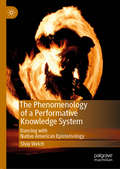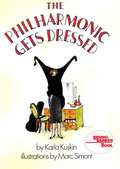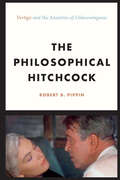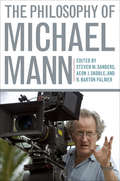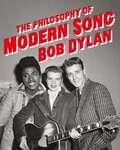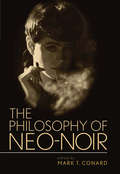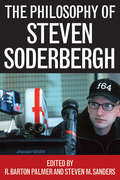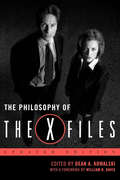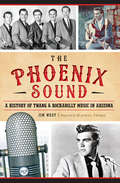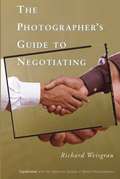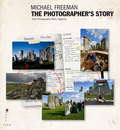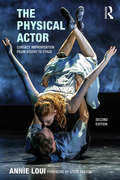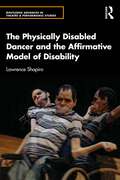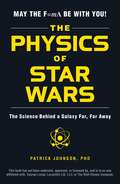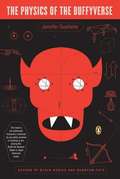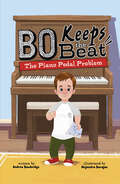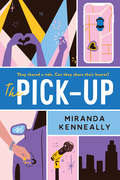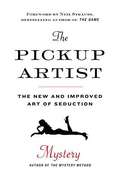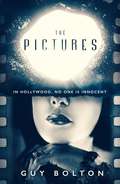- Table View
- List View
The Phenomenology of a Performative Knowledge System: Dancing with Native American Epistemology (Performance Philosophy)
by Shay WelchThis book investigates the phenomenological ways that dance choreographing and dance performance exemplify both Truth and meaning-making within Native American epistemology, from an analytic philosophical perspective. Given that within Native American communities dance is regarded both as an integral cultural conduit and “a doorway to a powerful wisdom,” Shay Welch argues that dance and dancing can both create and communicate knowledge. She explains that dance—as a form of oral, narrative storytelling—has the power to communicate knowledge of beliefs and histories, and that dance is a form of embodied narrative storytelling. Welch provides analytic clarity on how this happens, what conditions are required for it to succeed, and how dance can satisfy the relational and ethical facets of Native epistemology.
The Philharmonic Gets Dressed
by Karla KuskinThe 105 members of the Philharmonic Orchestra get ready for a performance. For children.
The Philosophical Hitchcock: “Vertigo” and the Anxieties of Unknowingness
by Robert B. PippinOn the surface, The Philosophical Hitchcock: Vertigo and the Anxieties of Unknowingness, is a close reading of Alfred Hitchcock’s 1958 masterpiece Vertigo. This, however, is a book by Robert B. Pippin, one of our most penetrating and creative philosophers, and so it is also much more. Even as he provides detailed readings of each scene in the film, and its story of obsession and fantasy, Pippin reflects more broadly on the modern world depicted in Hitchcock’s films. Hitchcock’s characters, Pippin shows us, repeatedly face problems and dangers rooted in our general failure to understand others—or even ourselves—very well, or to make effective use of what little we do understand. Vertigo, with its impersonations, deceptions, and fantasies, embodies a general, common struggle for mutual understanding in the late modern social world of ever more complex dependencies. By treating this problem through a filmed fictional narrative, rather than discursively, Pippin argues, Hitchcock is able to help us see the systematic and deep mutual misunderstanding and self-deceit that we are subject to when we try to establish the knowledge necessary for love, trust, and commitment, and what it might be to live in such a state of unknowingness. A bold, brilliant exploration of one of the most admired works of cinema, The Philosophical Hitchcock will lead philosophers and cinephiles alike to a new appreciation of Vertigo and its meanings.
The Philosophy of Argument and Audience Reception
by Christopher W. TindaleRecent work in argumentation theory has emphasized the nature of arguers and arguments along with various theoretical perspectives. Less attention has been given to the third feature of any argumentative situation - the audience. This book fills that gap by studying audience reception to argumentation and the problems that come to light as a result of this shift in focus. Christopher W. Tindale advances the tacit theories of several earlier thinkers by addressing the central problems connected with audience considerations in argumentation, problems that earlier philosophical theories overlook or inadequately accommodate. The main tools employed in exploring the central issues are drawn from contemporary philosophical research on meaning, testimony, emotion and agency. These are then combined with some of the major insights of recent rhetorical work in argumentation to advance our understanding of audiences and suggest avenues for further research.
The Philosophy of Film Noir (The Philosophy of Popular Culture #Ppcs)
by Mark T. ConardAn essay collection examining the philosophical elements of select films in noir cinema, as well as the genre’s legacy in film and culture.A drifter with no name and no past, driven purely by desire, is convinced by a beautiful woman to murder her husband. A hard-drinking detective down on his luck becomes involved with a gang of criminals in pursuit of a priceless artifact. The stories are at once romantic, pessimistic, filled with anxiety and a sense of alienation, and they define the essence of film noir. Noir emerged as a prominent American film genre in the early 1940s, distinguishable by its use of unusual lighting, sinister plots, mysterious characters, and dark themes. From The Maltese Falcon (1941) to Touch of Evil (1958), films from this classic period reflect an atmosphere of corruption and social decay that attracted such accomplished directors as John Huston, Alfred Hitchcock, Billy Wilder, and Orson Welles.The Philosophy of Film Noir is the first volume to focus exclusively on the philosophical underpinnings of these iconic films. Drawing on the work of diverse thinkers, from the French existentialist Albert Camus to the Frankurt school theorists Max Horkheimer and Theodor Adorno, the volume connects film noir to the philosophical questions of a modern, often nihilistic, world. Opening with an examination of what constitutes noir cinema, the book interprets the philosophical elements consistently present in the films—themes such as moral ambiguity, reason versus passion, and pessimism. The contributors to the volume also argue that the essence and elements of noir have fundamentally influenced movies outside of the traditional noir period. Neo-noir films such as Pulp Fiction (1994), Fight Club (1999), and Memento (2000) have reintroduced the genre to a contemporary audience. As they assess the concepts present in individual films, the contributors also illuminate and explore the philosophical themes that surface in popular culture.A close examination of one of the most significant artistic movements of the twentieth century, The Philosophy of Film Noir reinvigorates an intellectual discussion at the intersection of popular culture and philosophy.Praise for The Philosophy of Film Noir“The essays work both as solid primers into philosophy, stretching from Aristotle to Schopenhauer, and as lucid excursions into the genre’s dark, mean streets. . . . A fascinating, readable, and provocative book. . . . Highly recommended.” —Choice“Dense and intriguing, the book suggests noir is best perceived as a slightly warped mirror held up to contemporary society.” —Publishers Weekly
The Philosophy of Michael Mann (The Philosophy of Popular Culture)
by Aeon J. Skoble R. Barton Palmer Steven SandersA collection of essays exploring the philosophical themes and aesthetic vision behind blockbuster film including The Insider, Public Enemies,and more.Known for his finely crafted crime thrillers, American filmmaker Michael Mann has long been regarded as a talented triple threat capable of moving effortlessly between television and feature films as a writer, director, and executive producer. His unique visual sense and thematic approach are evident in the Emmy Award-winning The Jericho Mile, the cult favorite The Keep, the American epic The Last of the Mohicans, and the Academy Award-nominated The Insider, as well as more recent works such as Ali, Miami Vice, and Public Enemies.The Philosophy of Michael Mann provides a comprehensive account of the work of this highly accomplished filmmaker, exploring the director's recognizable visual style and the various on-screen and philosophical elements he has tested in his thirty-five-year career. The essays in this wide-ranging book will appeal to fans of the revolutionary filmmaker and to philosophical scholars interested in the themes and conflicts that drive his movies.
The Philosophy of Modern Song
by Bob DylanThe Philosophy of Modern Song is Bob Dylan&’s first book of new writing since 2004&’s Chronicles: Volume One — and since winning the Nobel Prize for Literature in 2016. Dylan, who began working on the book in 2010, offers a masterclass on the art and craft of songwriting. He writes over 60 essays focusing on songs by other artists, spanning from Stephen Foster to Elvis Costello, and in between ranging from Hank Williams to Nina Simone. He analyses what he calls the trap of easy rhymes, breaks down how the addition of a single syllable can diminish a song and even explains how bluegrass relates to heavy metal. These essays are written in Dylan&’s unique prose. They are mysterious and mercurial, poignant and profound, and often laugh-out-loud funny. And while they are ostensibly about music, they are really meditations and reflections on the human condition. Running throughout the book are nearly 150 carefully curated photos as well as a series of dream-like riffs that, taken together, resemble an epic poem and add to the work&’s transcendence. In 2020, with the release of his outstanding album Rough and Rowdy Ways, Dylan became the first artist to have an album hit the Billboard Top 40 in each decade since the 1960s. The Philosophy of Modern Song contains much of what he has learned about his craft in all those years and, like everything that Dylan does, it is a momentous artistic achievement.
The Philosophy of Neo-Noir (The Philosophy of Popular Culture #Ppcs)
by Mark T. ConardA collection of essays exploring the philosophical elements present in Neo-Noir films.Film noir is a classic genre characterized by visual elements such as tilted camera angles, skewed scene compositions, and an interplay between darkness and light. Common motifs include crime and punishment, the upheaval of traditional moral values, and a pessimistic stance on the meaning of life and on the place of humankind in the universe. Spanning the 1940s and 1950s, the classic film noir era saw the release of many of Hollywood’s best-loved studies of shady characters and shadowy underworlds, including Double Indemnity, The Big Sleep, Touch of Evil, and The Maltese Falcon. Neo-noir is a somewhat loosely defined genre of films produced after the classic noir era that display the visual or thematic hallmarks of the noir sensibility.The essays collected in The Philosophy of Neo-Noir explore the philosophical implications of neo-noir touchstones such as Blade Runner, Chinatown, Reservoir Dogs, Memento, and the films of the Coen brothers. Through the lens of philosophy, Mark T. Conard and the contributors examine previously obscure layers of meaning in these challenging films. The contributors also consider these neo-noir films as a means of addressing philosophical questions about guilt, redemption, the essence of human nature, and problems of knowledge, memory and identity. In the neo-noir universe, the lines between right and wrong and good and evil are blurred, and the detective and the criminal frequently mirror each other's most debilitating personality traits. The neo-noir detective?more antihero than hero?is frequently a morally compromised and spiritually shaken individual whose pursuit of a criminal masks the search for lost or unattainable aspects of the self. Conard argues that the films discussed in The Philosophy of Neo-Noir convey ambiguity, disillusionment, and disorientation more effectively than even the most iconic films of the classic noir era. Able to self-consciously draw upon noir conventions and simultaneously subvert them, neo-noir directors push beyond the earlier genre's limitations and open new paths of cinematic and philosophical exploration.Praise for The Philosophy of Neo-Noir“Conard can feel confident that these terrific essays will be of interest to film enthusiasts, particularly fans of Neo-Noir. Additionally, for those who come to this volume with some background in philosophy, not only will they be pleased to find fellow philosophers offering accessible introductions to philosophical thinkers and ideas but they are sure to increase their understanding of noir, Neo-Noir, and many familiar film titles, as well as more deeply appreciate the ways in which popular film and television offer wide and varied avenues to doing good philosophy.” —Kimberly A. Blessing, co-editor of Movies and the Meaning of Life“Taking up such latter-day classics as Chinatown, Blade Runner, and Memento, this volume explores how contemporary filmmakers have taken up the challenge of classic film noir and broadened the genre. In this analysis, even the pastel shades of South Beach take on a dark coloring in Miami Vice. These probing essays locate what is neo in Neo-Noir and thus define it as a postmodern genre.” —Paul Cantor, author of Gilligan Unbound: Pop Culture in the Age of Globalization“This collection will serve as a terrific interdisciplinary guide through the chaotic, intriguing world of postmodernist thought as it relates to film and philosophy.” —Choice
The Philosophy of Science Fiction Film (The\philosophy Of Popular Culture Ser.)
by Steven M. SandersThought-provoking essays on movies from Metropolis to The Matrix. The science fiction genre, through films such as Blade Runner, Invasion of the Body Snatchers, and The Terminator, not only entertains us but makes us think—about the implications of new technologies, the parameters and possibilities of space and time, and, in the age of artificial intelligence and robotics, the meaning of humanity itself. The Philosophy of Science Fiction Film explores the storylines, conflicts, and themes of fifteen science fiction film classics. Editor Steven M. Sanders and a group of outstanding scholars in philosophy, film studies, and other fields raise science fiction film criticism to a new level by penetrating the surfaces of the films to expose the underlying philosophical arguments, ethical perspectives, and metaphysical views.
The Philosophy of Steven Soderbergh (The Philosophy of Popular Culture #Ppcs)
by R. Barton Palmer and Steven M. Sanders&“Provocative, insightful, and instructive analysis of the cinematic and philosophical significance of Steven Soderbergh&’s work.&” —Jason Holt, editor of The Daily Show and Philosophy: Moments of Zen in the Art of Fake News Widely regarded as a turning point in American independent cinema, Steven Soderbergh's sex, lies, and videotape launched the career of its twenty-six-year-old director, whose debut film was nominated for an Academy Award and went on to win the Cannes Film Festival&’s top award, the Palme d&’Or. The Philosophy of Steven Soderbergh breaks new ground by investigating salient philosophical themes through the unique story lines and innovative approaches to filmmaking that distinguish this celebrated artist. Editors R. Barton Palmer and Steven M. Sanders have brought together leading scholars in philosophy and film studies for the first systematic analysis of Soderbergh&’s entire body of work, offering the first in-depth exploration of the philosophical ideas that form the basis of the work of one of the most commercially successful and consistently inventive filmmakers of our time.
The Philosophy of The X-Files: Updated Edition (The Philosophy of Popular Culture #Ppcs)
by Dean A. KowalskiLearn to search for the truth that&’s out there in essays about what &“may be the most philosophically challenging series in the history of television&” (Paul A. Cantor, author of Gilligan Unbound: Pop Culture in the Age of Globalization). In The Philosophy of The X-Files, Dean A. Kowalski has gathered a remarkable cast of contributors to shed light on the philosophical mysteries of the television show The X-Files. With sections devoted to the show&’s credos—&“The truth is out there,&” &“Trust no one,&” and &“I want to believe&” —as well as individual characters and specific episodes, The Philosophy of The X-Files illuminates the philosophical assumptions and presuppositions of the show and provides a lively, accessible way to better understand philosophy and philosophical inquiry—while exploring topics ranging from alienation to determinism to democracy.
The Philosophy of the Coen Brothers (The Philosophy of Popular Culture #Ppcs)
by Mark T. Conard&“Written for both fans of the Coen brothers and the philosophically curious, without the technical language . . . educational and entertaining.&” —Library Journal Joel and Ethan Coen have made films that redefined the gangster movie, the screwball comedy, the fable, and the film noir, but no matter what genre they&’re playing with, they consistently focus on the struggles of complex characters to understand themselves and their places in the strange worlds they inhabit. To borrow a phrase from Barton Fink, all Coen films explore &“the life of the mind&” and show that the human condition can often be simultaneously comic and tragic, profound and absurd. The essays in this book explore the challenging moral and philosophical terrain of the Coen repertoire. Several address how Coen films often share film noir&’s essential philosophical assumptions: power corrupts, evil is real, and human control of fate is an illusion. In Fargo, not even Minnesota&’s blankets of snow can hide Jerry Lundegaard&’s crimes or brighten his long, dark night of the soul. The tale of love, marriage, betrayal, and divorce in Intolerable Cruelty transcends the plight of the characters to illuminate competing theories of justice. Even in lighter fare, such as Raising Arizona and The Big Lebowski, the comedy emerges from characters&’ journeys to the brink of an amoral abyss. However, the Coens often knowingly and gleefully subvert conventions and occasionally offer symbolic rebirths and other hopeful outcomes. At the end of The Big Lebowski, for example, the Dude abides, his laziness has become a virtue, and the human comedy is perpetuating itself with the promised arrival of a newborn Lebowski. The Philosophy of the Coen Brothers sheds new light on the work of these cinematic visionaries. From Blood Simple to No Country for Old Men, the Coens&’ characters look for answers—though in some cases, their quest for answers leads, at best, only to more questions.
The Philosophy of the Western (The Philosophy of Popular Culture #Ppcs)
by Jennifer L. McMahon and B. Steve CsakiEssays about how stories of the Old West reflect—and affect—our beliefs and values.The solitude of the lone rider, the loyalty of his horse, and the unspoken code of the West—for many, Western movies embody America and its values, though the view of the country&’s history they present isn&’t always accurate. In recent years, scholars had declared the genre dead, but a steady resurgence of western themes in literature, film, and television has reestablished its importance and influence.In The Philosophy of the Western, editors Jennifer L. McMahon and B. Steve Csaki examine philosophical themes in the western genre. Investigating subjects of nature, ethics, identity, gender, environmentalism, and animal rights, the essays in this volume draw from a wide range of westerns including the more recent popular and critical successes Unforgiven, All the Pretty Horses, 3:10 to Yuma, and No Country for Old Men, as well as literature and television serials such as Deadwood. The Philosophy of the Western reveals the powerful role of the western in the American psyche.
The Phoenix Sound: A History Of Twang And Rockabilly Music In Arizona
by Jim WestIn 1956, a fresh-faced Sanford Clark recorded "The Fool" with guitarist Al Casey at Floyd Ramsey's small Phoenix recording studio. Written by local deejay Lee Hazlewood, the song became a top-ten Billboard hit nationwide and launched a new trailblazing era of Arizona music. Their success paved the way for other Phoenix acts and producers to chart national hits. Grammy-winning audio engineer Jack Miller started out in Ramsey's studio, and Hazlewood produced rock hall of famer Duane Eddy's debut album, Have "Twangy" Guitar, Will Travel. These early artists pioneered a sound that inspired Arizona's best musicians from Waylon Jennings and Buck Owens to Stevie Nicks and Linda Ronstadt. Join former radio and broadcast personality Jim West for the story and soundtrack to the early days of music in the Valley of the Sun.
The Photographer's Guide to Negotiating
by Richard WeisgrauNegotiating is a crucial skill for anyone running a business, but they don't teach this art in photography school. The Photographer's Guide to Negotiating gives specific tips for negotiating assignment deals, digital and electronic rights, stock photography sales, contracts, purchases, and more. Interviews with an art buyer, a photographer, and a photographer's rep give photographers extra insight-and maybe even the upper hand in many negotiations. Everyone negotiates in everyday life. This book shows photographers how to take those skills and successfully apply them to business deals.Allworth Press, an imprint of Skyhorse Publishing, publishes a broad range of books on the visual and performing arts, with emphasis on the business of art. Our titles cover subjects such as graphic design, theater, branding, fine art, photography, interior design, writing, acting, film, how to start careers, business and legal forms, business practices, and more. While we don't aspire to publish a New York Times bestseller or a national bestseller, we are deeply committed to quality books that help creative professionals succeed and thrive. We often publish in areas overlooked by other publishers and welcome the author whose expertise can help our audience of readers.
The Photographer's Story: The Art Of Visual Narrative
by Michael FreemanThis title shows how classic photo stories are shot and edited, giving aspiring photojournalists and hobbyists alike a wealth of ideas to unlock the potential of their most powerful storytelling tool - their camera.
The Physical Actor: Contact Improvisation from Studio to Stage
by Annie LouiThe Physical Actor is a comprehensive book of exercises for actors. It is carefully designed for the development of a strong and flexible physical body able to move with ease through space and interact instinctively on-stage. Annie Loui draws on her training with Etienne Decroux, Carolyn Carlson, and Jerzy Grotowski to bring Contact Improvisation into the theatrical sphere. She explains how it can be used to develop alert and embodied listening skills in the actor, and how to apply it to working with texts on stage. This book will guide the reader through a full course of movement skills, including: Partnering skills Spatial awareness for groups and individuals Fine motor control through mime Heightened co-ordination and sustained motion New for this edition are additional partnering exercises, in-depth applications of contact improvisation to monologues and scenes, and a chapter on devising physical theatre performances.
The Physically Disabled Dancer and the Affirmative Model of Disability (Routledge Advances in Theatre & Performance Studies)
by Lawrence ShapiroThis volume investigates the contributions and achievements of the physically disabled dancer while challenging and recognizing the inherent inequities in the field of integrated dance in the UK which currently places greater emphasis on the learning‑disabled performer. This is the first book ever written by a physically disabled dancer on the subject of physically disabled dancers. Inherent in this examination is the model of examining disability that is most closely associated with the disability arts movement which is the ‘affirmative model of disability’. This model is defined as an approach to disability in which the disabled person is neither an object of medical care nor a victim of social indifference but a self‑respecting, autonomous individual in which their disability is a positive and affirming aspect of their self‑identity. This book, based on interviews with physically disabled dancers, choreographers, academics and arts producers all in a UK context, combines a wide range of perspective of disability dance together with the intellectual rigour of disability studies to produce a new definition of the physically disabled dancer as an affirming, positive, indispensable practitioner of contemporary performance art. The volume pioneers perspectives of the physically disabled dancer prioritizing first‑person accounts from the performers themselves to produce an unprecedented contribution to the study of disability arts from a uniquely British perspective.This book will offer educators as well as arts and cultural professionals a critical resource for facilitating work by and in alliance with practitioners of integrated dance.
The Physics of Star Wars: The Science Behind a Galaxy Far, Far Away
by Patrick JohnsonExplore the physics behind the world of Star Wars, with engaging topics and accessible information that shows how we’re closer than ever before to creating technology from the galaxy far, far away—perfect for every Star Wars fan! Ever wish you could have your very own lightsaber like Luke Skywalker and Obi-Wan Kenobi? Or that you could fly through space at the speed of light like Han Solo and Poe Dameron? Well, those ideas aren’t as outlandish as you think. In The Physics of Star Wars, you’ll explore the mystical power of the Force using quantum mechanics, find out how much energy it would take for the Death Star or Starkiller Base to destroy a planet, and discover how we can potentially create our very own lightsabers. The fantastical world of Star Wars may become a reality!
The Physics of the Buffyverse
by Jennifer OuellettePhysics with a Buffy the Vampire Slayer pop-culture chaser In the tradition of the bestselling The Physics of Star Trek, acclaimed science writer Jennifer Ouellette explains fundamental concepts in the physical sciences through examples culled from the hit TV shows Buffy the Vampire Slayer and its spin-off, Angel. The weird and wonderful world of the Buffyverse-where the melding of magic and science is an everyday occurrence-provides a fantastical jumping-off point for looking at complex theories of biology, chemistry, and theoretical physics. From surreal vampires, demons, and interdimensional portals to energy conservation, black holes, and string theory, The Physics of the Buffyverse is serious (and palatable) science for the rest of us. .
The Piano Pedal Problem (Bo Keeps the Beat)
by Andrew BambridgeBo really wants to take piano lessons like his older brother Jason. But there are two problems—his mom says he’s not ready, and his feet can’t reach the foot pedals because of his achondroplasia. But Bo knows that where there’s a problem, there’s a solution! With determination and the help of a kind teacher, Bo tackles the piano problem, and his feet and fingers finally feel the music! Musician, educator, and actor Andrew Bambridge (Pixels) offers a charming chapter book series about a boy named Bo who, like Andrew, has achondroplasia and has always loved music.
The Pick-Up
by Miranda KenneallyMeeting a gorgeous guy in a rideshare headed to Lollapalooza is not how Mari expected her Chicago summer to start. She doesn't believe in dating...but TJ may just change her mind. Can an electric, weekend romance turn into more than just a summer fling?When Mari hails a Ryde to a music festival, the last thing she expects is for the car to pick up a gorgeous guy along the way. Mari doesn't believe in dating—it can only end with a broken heart. Besides, she's only staying at her dad's house in Chicago for the weekend. How close can you get to a guy in three days?TJ wants to study art in college, but his family's expectations cast a long shadow over his dreams. When he meets Mari in the back of a rideshare, he feels alive for the first time in a long time.Mari and TJ enter the festival together and share an electric moment but get separated in a crowd with seemingly no way to find each other. When fate reunites them (with a little help from a viral hashtag), they'll have to decide: was it love at first sight, or the start of nothing more than a weekend fling?
The Pickup Artist: The New and Improved Art of Seduction
by Mystery Chris OdomThe world's greatest pickup artist is back! After the bestselling expose The Game pulled back the curtain on Mystery and his culture of professional pickup artists, he became an international phenomenon. Unfortunately, while it's no secret that Mystery's ideas are wildly effective, women have started to catch on. They've seen the show and heard the routines-so now it's time for the next level of game! With techniques honed over fifteen years of trial, error, and ultimate triumph, and following his hit VH1 reality series, the celebrated sensei is back with his latest living-large exploits and a new and improved playbook for the twenty-first-century playboy. As the book begins, Mystery and his crew have withdrawn to their swank Miami mansion to plot their next move. When a new student comes to stay at the house, Mystery draws him deep into the pickup-artist lifestyle and shows him an intimate portrait of the master of seduction. Mystery lays out a complete system of game, and unveils his latest (and fully field-tested) strategies and techniques. The Pickup Artist includes * a list of all the triggers that create-and destroy-attraction * a new way to approach strangers and start a conversation: microcalibrated openers * Mystery's most powerful humor technique, the Absurd-so you'll never run out of things to say again * a full chapter on physical escalation (touching, kissing, "making a move") * the solution to inner-game issues, for when you're not confident enough * and much, much more. Whether he's holding court with eager disciples in South Beach, hanging out with his crew of fellow super-seducers in Las Vegas, or partying it up in the Hollywood Hills, Mystery is never far from where the action is-and never fails to get a piece of it. Now it's your turn. Read The Pickup Artist and get into the game.
The Picture of Abjection: Film, Fetish, and the Nature of Difference
by Tina Chanter“A timely and important project that changes our understanding of the role of abjection both in cultural politics and in the structure of film.” —Ewa Ziarek, State University of New York at BuffaloTina Chanter resolves a fundamental problem in film theory by negotiating a middle path between “gaze theory” approaches to film and spectator studies or cultural theory approaches that emphasize the position of the viewer and thereby take account of race, class, gender, and sexuality. Chanter argues that abjection is the unthought ground of fetishistic theories. If the feminine has been the privileged excluded other of psychoanalytic theory, fueled by the myth of castration and the logic of disavowal, when fetishism is taken up by race theory, or cultural theory, the multiple and fluid registers of abjection are obscured. By mobilizing a theory of abjection, the book shows how the appeal to phallic, fetishistic theories continues to reify the hegemonic categories of race, class, sexuality, and gender, as if they stood as self-evident categories.“An intriguing read, especially for those who favor psychological models of criticism in film theory . . . Recommended.” —Choice
The Pictures (Detective Craine Ser. #1)
by Guy Bolton*Shortlisted for the John Creasey (New Blood) Dagger Award 2017* World-weary Jonathan Craine is a detective at the LAPD who has spent his entire career as a studio &‘fixer&’, covering up crimes of the studio players to protect the billion-dollar industry that built Los Angeles. When one of the producers of The Wizard of Oz is found dead under suspicious circumstances, Craine must make sure the incident passes without scandal and that the deceased&’s widow, the beautiful starlet Gale Goodwin, comes through the ordeal with her reputation unscathed. But against his better instincts, Craine finds himself increasingly drawn to Gale. And when a series of unsavoury truths begin to surface, Craine finds himself at the centre of a conspiracy involving a Chicago crime syndicate, a prostitution racket and a set of stolen pictures that could hold the key to unravelling the mystery.
